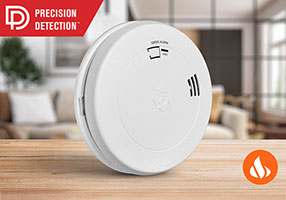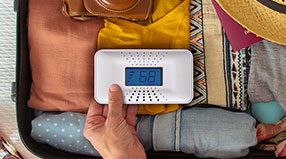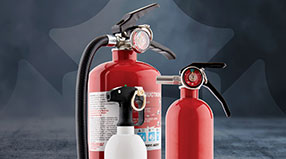Smoke Alarms and Smoke Detectors
Common Questions About First Alert Smoke Alarms
Where should I be installing smoke alarms?
You should be placing smoke alarms at least 20 ft. from appliances such as furnaces and ovens as these produce combustion particles. Smoke detectors should also be at least 10 ft. from high humidity areas such as bathrooms (with showers) and laundry rooms. Heating and AC vents are also capable of disrupting smoke alarms, so you’ll generally want to place them at least 3 ft. away from them. As for actual locations, it’s generally recommended that smoke alarms be installed inside each bedroom (or area where people usually sleep), just outside of bedrooms and on every level of a home. This would include basements. You’ll find that a battery powered smoke alarm allows for a little more freedom with your selection as you won’t be limited by a hardwired setup.
Why should I replace my smoke alarms every 10 years?
Every smoke alarm in your home has an expiration date. It’s something that all homeowners should be aware of as smoke and fire protection is only available with an active alarm. If you’re unsure of the time remaining on your smoke alarm, there’s an easy way to check its viability. Most smoke detectors will feature a manufacturer date printed on the back of the alarm. If it’s more than 10 years old, it’s time to replace the smoke detector. The same applies to carbon monoxide alarms. It should be noted that most co alarms expire after 7 years.
What is the difference between ionization and photoelectric smoke alarms?
Ionization Smoke Detectors feature an ionization sensor that provides the earliest possible warning to fast flaming fires. Ionization sensors are optimized to detect fast flaming fires that can be caused by paper, kitchen grease and other fast-combusting materials. Photoelectric Smoke Detectors come equipped with a photoelectric sensor that reliably detects smoke produced by smoldering fires. Photoelectric sensors are optimized to detect larger smoke particles created by smoldering fires such as those caused by unextinguished cigarettes.
What about dual sensor smoke alarms?
Dual sensor smoke alarms excel at detecting the presence of both smoldering and fast-flaming fires, ensuring optimal levels in peace of mind. Both sensors work together to provide complete smoke and fire detection.
Does First Alert offer hearing impaired alarms?
Yes, First Alert Alarms equipped with LED strobe lights are available for online purchase. All First Alert Hearing Impaired Alarms meet UL Standards while fulfilling the requirements of the American with Disabilities Act. Hearing impaired alarms with LED strobe lights have also been recommended by the National Fire Protection Association (NFPA). First Alert Strobe Lights can be interconnected with other hardwired detectors setup throughout your home. Hardwired Strobe Light Alarms can operate independently or be interconnected with other hardwired alarms for increased protection.



